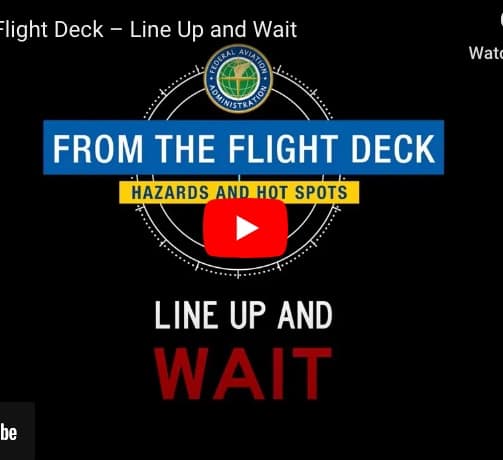In 2023, pilots in 50 aircraft were instructed by air traffic control to Line Up and Wait. Instead, they Lined Up and Went.
That is according to an FAA video titled “From the Flight Deck — Line Up and Wait” posted to YouTube on Oct. 16, 2024.
After watching the video, I wondered how many pilots who heard Line Up and Wait actually waited after being instructed to do so.
Air Traffic by the Numbers, an FAA report, states on page 7 that nearly 30 million flights happened in FY2023, including 15,712,724 under IFR rules, 14,066,291 under VFR rules.
Of course, there is no way of knowing how many of those flights included instructions to Line Up and Wait.
Rather than dive into actual data, the FAA video introduced viewers to expectation bias, habit intrusion, and prospective memory. Good topics for discussion and education to be sure.
But readers at our website mostly bypassed the FAA’s takeaways and pointed to the transition from Taxi into Position and Hold to Line Up and Wait as the primary culprit.
“Years ago, our former Taxi Into Position and Hold (TIPAH) became Line Up and Wait (LUAW) in the FAA’s deference to compliance with ICAO phraseology,” wrote Mike Finkle. “While I completely understand the goal of having aviation terminology/phraseology be the same worldwide, I have always strongly believed that ICAO should have changed theirs to comply with the FAA’s rather than the other WAY around.
“LUAW does not communicate remotely near the clarity and specificity of TIPAH,” he continued. “The TIP portion of the phrase is extremely clear in that the aircraft is only cleared to its specific takeoff POSITION on the runway. The AH portion is even further extremely clear in that the aircraft is to HOLD in that POSITION. LUAW is far less intrinsically clear…line up where and wait for what?
“I would be very interested to see the statistical data on the percentage of LUAW clearances that resulted in unauthorized takeoffs versus TIPAH clearances that resulted in unauthorized takeoffs. I strongly suspect that the data would show that LUAW was a factor FAR more often. Of course, we still need to put the primary blame on the flight crew, whether it is a one, two, or three person one, but I believe that fundamentally clearer phraseology would help.”
It would be interesting to see the deviation data comparing Taxi Into Position and Hold versus Line Up and Wait. However, with just 50 occurrences in 2023 it would appear the vast majority of pilots got, and understood, the LUAW memo.
“As a former CFI of 30 years, I’ve been curious about this same issue. What safety statistic constituted the need to change Position and Hold to Line Up and Wait for better safety?” asks Jimmy McPhail. “They didn’t change Hold Short of Runway 21 to Wait Short of Runway 21, for example. If the change is supposed to convey a clearer instruction from the tower, I don’t see it.”
I believe the transition to Line Up and Wait was more about standardizing communication internationally than a specific safety statistic. But, if successful, the transition to LUAW should lead to safer global operations.
“I too remember when the verbiage change took place. There were several factors driving this as previously mentioned. Another reason for the change was the pilot responses. If given a clearance to Taxi Into Position and Hold, a response might be ‘On to Hold.’ If given a clearance to Hold Short a response often heard was ‘On the Hold.’ This did lead to many clearance failures,” states Benjamin Gillam. ”US pilots and controllers often take short cuts with radio transmissions that are not heard internationally. International pilots flying overseas learn quickly to repeat instructions back EXACTLY as given. By now Line Up and Wait should be fully incorporated and familiar. If not, it should be highlighted during training. There may be a better phrase but I would hate to make another change during this critical phase. Just my $0.02.”
The Skybrary website reports, “In September 2010 the Federal Aviation Administration (FAA) amended JO 7110.65 (Air Traffic Control) by replacing the phrase ‘Taxi Into position and Hold (TIPH)’ with ‘Line Up and Wait (LUAW).”
So, 14 years in, LUAW should be familiar, but some habits die hard.
Multiple comments refer to international operations, which I interpret as primarily commercial operations. So, those of us flying non-commercial in the United States got to absorb the change in nomenclature in support of our international commercial aviation siblings.
But any way you slice it, 50 failed instances out of millions of operations is a pretty remarkable number. We can always do better, but dang, well done.


